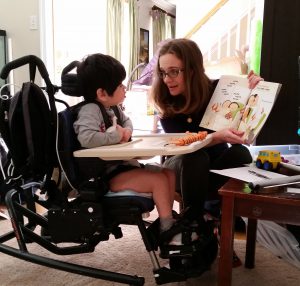 On Monday, Joey said “Dog Firetruck” on his AAC device, looked at me, and then carefully used one finger to point to the box on the floor that contained Dot the Fire Dog book and the props we use while we read aloud. Although it seemed like a small thing – two words together paired with a gesture, in turns of language development, this is a big deal. Seeing him pair language with his gestures shows that he is building an understanding of communication, and how we interact together. He can use gestures and words to communicate with me and expect that I’ll respond.
On Monday, Joey said “Dog Firetruck” on his AAC device, looked at me, and then carefully used one finger to point to the box on the floor that contained Dot the Fire Dog book and the props we use while we read aloud. Although it seemed like a small thing – two words together paired with a gesture, in turns of language development, this is a big deal. Seeing him pair language with his gestures shows that he is building an understanding of communication, and how we interact together. He can use gestures and words to communicate with me and expect that I’ll respond.
One of my constant goals for Joey is for him to engage in back and forth interactions with those of us in his environment. Sometimes, these interactions are called “serve and return”, and the Harvard Center for the Developing Child has excellent videos and tip guides to help explain these interactions.
This afternoon I was able to participate in a webinar with the researcher Rachel Romeo, discussing her work Beyond the 30 Million Word Gap. Her research sought to use fMRI to measure the brain implications behind the 30 Million Word Gap. This gap refers to the amount of words children from different socio-economic backgrounds hear in early childhood, and is a study that has been replicated, but never using fMRI machines. The hope was to view the brain scans to understand the neuro implications behind the word gap. Romeo and her fellow researchers found that what increased children’s brain development in the Broca’s area of the brain was not the amount of words they heard, but the amount of conversational turns they exchanged with an adult. These conversational turns, defined as one participant initiating conversation and receiving a response within five seconds, are also what Harvard’s Center for the Developing Child refers to as Serve and Returns.
But what does this research mean for Joey?
While it is easy to engage a child in a back and forth conversation about his day, favorite toy, or what he wants to eat for dinner, providing a nonverbal child with back and forth interactions can be more challenging. Instead of simply looking at oral language as a possibility for back and forth interactions, we need to instead consider alternative ways to have back and forth exchanges with Joey. This means being attuned to his gestural communication, however subtle, and responding to it. We can follow Joey’s eyes as they land on a specific toy, and respond to that as if he said, “I want that truck.” We can pull out that interaction further by playfully asking “You want… this car?” and wait for him to show us with a gesture that he does NOT want the car we are holding. “Oh! You want this truck!” we can confirm with him, before providing him with the truck. When we are playing, we can ask Joey questions like “What should the dinosaur eat next?” or “Where should the fire truck go?” and wait for his response through how he shifts his eyes or moves his arms. When he laughs, we can continue the game we are playing, looking for cues for what he wants to do next with the game, constantly pushing and expanding on our interactions. We can respond to his pointing and ask follow-up questions that may require him to use his eye gaze device. We can treat all his words on his eye gaze AAC device as meaningful and respond accordingly. When we put on his shoes we can ask him which foot he wants to put on first, and then wait for a response. When we transfer him from the floor to a seat we can wait for him to initiate before moving him.
Although it is easy to overlook gestural communication in our pursuit of building language, it is an essential developmental skill in developing meaningful communication. Engaging Joey in back and forth reciprocal interactions, may not only support his neurological language development, but also his sense of agency, sense of self, and build strong relationships with those around him.


